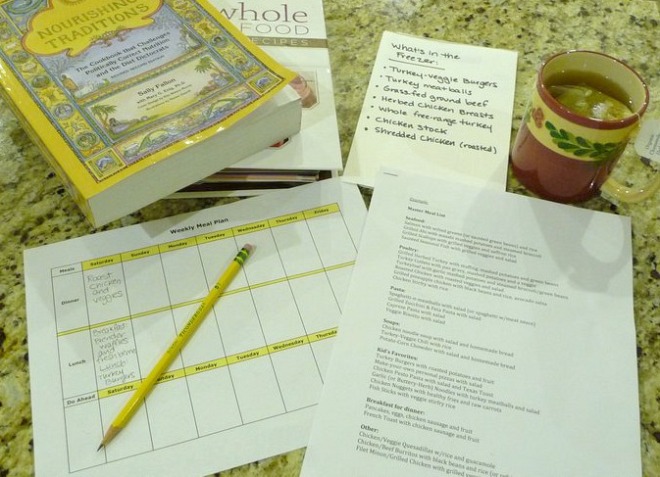
Did you know that a little organization in the form of a weekly meal plan goes a long way in keeping your family on track for eating healthier? It’s true!
Meals prepared at home generally contain a greater variety of nutrient-rich foods compared with those found at typical restaurants. Plus, by making your meals at home, you can significantly save money. A typical take-out meal costs the average family of four about $25. Yet, with this same amount of money, you can actually feed your family an entire day’s worth of nutritious whole food meals, including healthy snacks!
Of course, I understand that many of us have grown up in an era where cooking and meal planning haven’t been skills passed down to us. So, even though we know how important good nutrition is in keeping our families healthy, it can be hard to get a wholesome home-cooked meal on the table without an organized game plan.
So that’s where Sandra and I come in: We want to show you how easy and beneficial it is to incorporate meal planning into your weekly routine.
Fact is, this wonderful strategy will not only help your family to eat healthier and save money – it will also save you time and stress as well.
That’s because once you make your meal plan and purchase the ingredients needed for each of the meals outlined, you can then go on autopilot. Simply execute the meal plan day-by-day without having to stress over what’s for dinner, and without having to make multiple trips to the market.
How to Make a Weekly Meal Plan – Step by Step!
Shown below is an example of the free weekly meal plans that I provide at The Nourishing Home.
You can download this meal plan by clicking on the graphic above. Once you click on the meal plan graphic, be sure to save it to your computer. Then, simply click on the links within the meal plan pdf to gain instant access to each of the recipes. (Please note: Many mobile devices and tablets are not able to open links within a pdf document. So be sure to save the meal plans to your computer first.)
As you can see, my weekly meal plans cover an entire week’s menu. However, for those just getting started, I recommend that you take it slow. There’s no need to plan out every single meal. Instead, start with planning just a few meals each week, or planning meals only on the busiest days of the week. Then, once you see how easy and beneficial meal planning truly is, you’ll most certainly be inspired to add even more meals to your weekly meal plan!
So without further ado … here are the top five meal planning tips that I cover in detail at each of my meal planning seminars and in my popular eBook “Meal Planning Made Easy,” which is free to subscribers of The Nourishing Home.
1) Create a Master List of Meals
The first step in meal planning is to make a Master List of Meals, which is simply a list of all the meals that you make. Taking time to really think through this first step will save you a ton of time in the long run – no more racking your brain to try to think of what you should make for the week. Simply look at your Master List of Meals each time you make your weekly meal plan. As you start trying new recipes, remember to add the ones your family likes to your Master List of Meals.
2) Check Your Calendar!
Before you start selecting meals for the week ahead, first take a look at what’s happening each day, and plan your meals accordingly.
- On busy days, opt for quick and easy-to-prepare meals, such as crockpot and one-pot meals, easy pasta dishes, grilled/roasted meats, steamed vegetables, and salads.
- For extra-busy days, schedule a “leftovers night,” where you can simply warm up a meal from a previous evening.
- Be sure to save new recipes, or more complicated meals, for weekends.
3) Create Your Meal Plan
First, check your pantry and fridge to see what you already have on hand, and be sure to plan for meals that utilize these ingredients. Then, grab your Master List of Meals and your calendar, and get started!
Remember, even planning a few meals a week, or planning meals for just the busiest days of the week, will go a long way in helping you stay on track with your healthy-eating goals and budget, as well as save you time and stress!
4) Make a Shopping List
“The List” is your prime directive at the market, to keep you focused and save you time and money by limiting distractions. The List ensures you quickly get exactly what you need for the week ahead.
- Make your meal plan for the week, and then go through each meal and list out all the ingredients needed to create that meal. Be sure to check to see what you already have on hand. Any missing ingredients go on The List.
- Keep a pad of paper on your kitchen counter, and jot down items as you run out of them so they can quickly and easily be added to The List.
5) Schedule a Prep Day
Just an hour or two over the weekend can go a long way in making things quicker and easier for you during the week ahead! Use your prep day to accomplish tasks such as:
- Meats: Cut and divide meat into portions based on your meal plan, and freeze (you can even place the meat into a marinade and freeze). Use ground meat to mix and form into meatballs and burgers that can be frozen for later use. I also like to precook and freeze ground meat for use in meals such as tacos, chili, soups, etc.
- Veggies/Fruits: Chop any veggies/fruits needed for recipes (that can keep well once chopped). For example, I find it super-helpful to pre-chop, rinse, and store lettuce for salads for the week ahead.
- Other: Prepare anything that can be prepared ahead of time; e.g., bake a batch of healthy muffins, and freeze them for snacks for the week ahead. Grate cheese, make salad dressings or sauces, etc., and store them in the fridge or freezer.
And during the week, you can still be prepping ahead by doing time-saving steps such as batch cooking, which is covered in my post “Cook Once, Eat Twice or More.”
Bonus Tip: Get the Kids Involved!
Cooking with your kids is not only fun and educational – it’s also a great way to encourage them to expand their culinary horizons, since kids are more likely to eat what they help make.
So as you’re planning out your weekly meals, have the kids chime in with some ideas about what to put on the menu, and have them join you in the kitchen. You’ll be amazed at the difference this will make in reinforcing and building healthy eating habits that last a lifetime!
I want to thank Sandra for allowing me the opportunity to encourage you with some practical tips that make getting a healthy dinner on the table a whole lot easier.
If you’d like to learn more healthy meal planning strategies, as well as receive free weekly whole food meal plans and recipes, please visit me at The Nourishing Home. I’m always happy to help!
Kelly Smith loves the Lord, her family, and sharing her passion for whole food cooking and meal planning with others. She is a cookbook author and food blogger at TheNourishingHome.com– a site dedicated to sharing delicious gluten-free meal plans, recipes, cooking tips, and overall encouragement to help others in their quest to live a more nourished life. Kelly also teaches meal planning and whole food cooking classes at various venues in Southern California. You can also find her on Facebook, Instagram and Pinterest.




